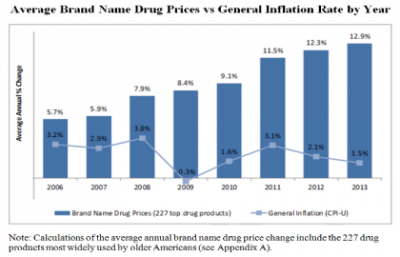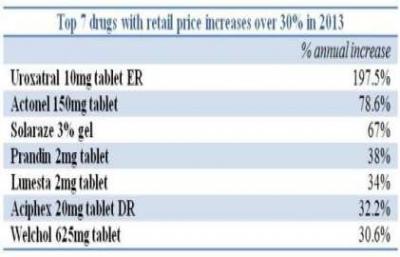Washington, DC—Retail prices for brand name prescription drugs widely used by older Americans shot up by an average of nearly 13% in 2013, more than eight times faster than the 1.5% general inflation rate, according to a new AARP Public Policy Institute (PPI) report released today. The report reveals the highest average annual price increase since AARP began tracking prescription drug prices in 2004.
“Higher brand name drug prices can increase health care premiums, deductibles, and other cost-sharing for everyone with health coverage, even for those who don’t take medications,” said AARP Executive Vice President for Policy, Strategy and International Affairs Debra Whitman. “If these price increases continue, we’ll likely see more people—particularly older people, who are often on fixed incomes—stop taking life-saving medications because they simply can’t afford them, leading to higher health care costs down the road.”
“The relentless rise in brand name drug prices also has implications for taxpayer-funded programs like Medicare and Medicaid,” said Whitman. “Higher government spending driven by large price increases eventually affects all Americans in the form of higher taxes, cuts to public programs, or both.”
Almost two-thirds of older Americans take three or more prescription drugs in a given year. For those who take three brand name prescription drugs on a regular basis, their annual cost of therapy would have been more than $8,800 during 2013—more than double the cost seen eight years earlier.
Additionally, increased prices for brand name medications lead to higher out-of-pocket costs for consumers who pay coinsurance, or a percentage of their drug costs, instead of a fixed dollar amount.
According to the AARP PPI report, policymakers should focus on exploring options that reduce the impact of increasing prescription drug prices. AARP continues to work with Congress to help lower prescription drug costs by requiring manufacturer rebates for drugs purchased by Medicare Part D low-income subsidy beneficiaries, improving the approval process for generic versions of biologic drugs, and giving Medicare the authority to negotiate prescription drug prices with drug makers.
Highlights of the Rx Price Watch Report
- The average annual retail price increase for widely used brand name prescription drugs was more than twice as high in 2013 (12.9%) as in 2006 (5.7%).
- In 2013, the average annual cost of one brand name medication used to treat a chronic health condition was nearly $3,000, compared with nearly $1,500 in 2006.
- Retail prices increased for 97% of the 227 brand name prescription drugs in the study’s market basket.
- Seven brand name drugs had average annual retail price increases of over 30% in 2013.
“The rise in prescription drug prices negatively impacts consumers, insurers, and employers, as well as taxpayer-funded programs like Medicare and Medicaid,” said Leigh Purvis, Director of Health Services Research, AARP Public Policy Institute, and co-author of the report. “We need to find policy solutions that balance the need for pharmaceutical innovation with the need for improved health and affordability.”
Rx Price Watch Report Methodology
AARP’s Public Policy Institute, in collaboration with the PRIME Institute at the University of Minnesota, developed a market basket of 227 brand name prescription drug products widely used by older Americans. Using data from the Truven Health MarketScan® Research Databases, the report analyzed retail price changes between 2006 and 2013 for the drug products in the market basket. The medications include products used to treat common and often chronic health conditions, including high cholesterol, diabetes, and hypertension.
# # #
About AARP
AARP is a nonprofit, nonpartisan organization, with a membership of nearly 38 million, that helps people turn their goals and dreams into real possibilities, strengthens communities and fights for the issues that matter most to families such as healthcare, employment and income security, retirement planning, affordable utilities and protection from financial abuse. We advocate for individuals in the marketplace by selecting products and services of high quality and value to carry the AARP name as well as help our members obtain discounts on a wide range of products, travel, and services. A trusted source for lifestyle tips, news and educational information, AARP produces AARP The Magazine, the world's largest circulation magazine; AARP Bulletin; www.aarp.org; AARP TV & Radio; AARP Books; and AARP en Español, a Spanish-language website addressing the interests and needs of Hispanics. AARP does not endorse candidates for public office or make contributions to political campaigns or candidates. The AARP Foundation is an affiliated charity that provides security, protection, and empowerment to older persons in need with support from thousands of volunteers, donors, and sponsors. AARP has staffed offices in all 50 states, the District of Columbia, Puerto Rico, and the U.S. Virgin Islands. Learn more atwww.aarp.org.
Contact:
Greg Phillips, 202-434-2560, gphillips@aarp.org, @AARPmedia

























































